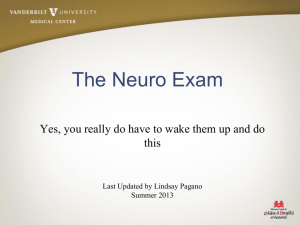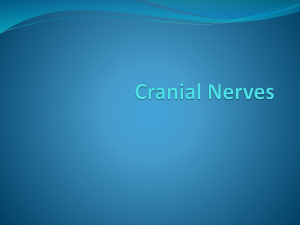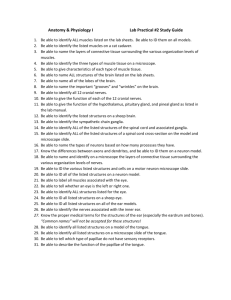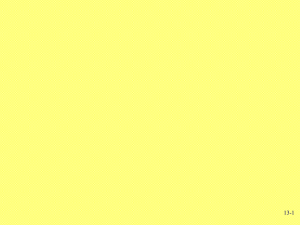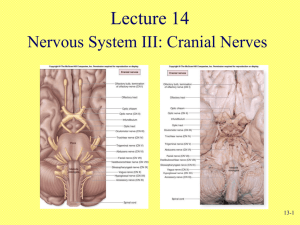Cranial Nerves - 34-602-Neuroanatomy-SP15
advertisement
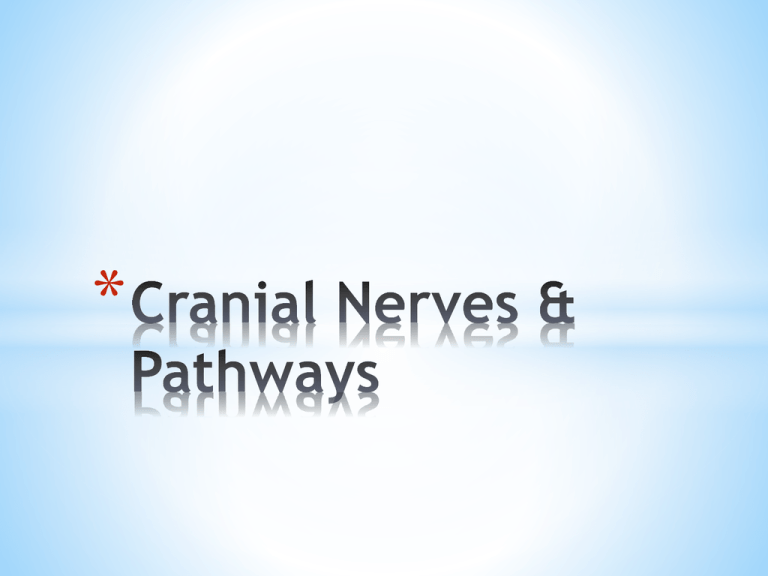
* * * * * * * * * * * * * * * Compare and Contrast cranial nerves to spinal nerves Know which cranial nerves are central and which are peripheral Know the 4 functions of all cranial nerves together Draw, interpret, and analyze the corticobrainstem tracts Explain the process of olfaction (receptors, CN I, cortical areas) Explain taste (receptors, CN VII & IX, solitary n.) Explain vision (visual field, anatomy & receptors, CN II, visual pathway) Explain coordination of eye movements (III, IV, VI efferents) Explain hearing (anatomy & receptors, CN VIII, auditory pathway) Explain sensory and motor control of face (CN V & VII) Explain swallowing & speaking (CN V, VII, IX, X efferents) Explain head control (CN XII efferents) Explain parasympathetic control of viscera (CN X) Describe or draw the auditory, visual, and pupillary pathways Special Senses Motor (and somatosensory) Autonomic * Cranial Nerves Spinal Nerves • Special senses • Vary in components (S, M, B) • From specialized nuclei in BS • Parasympathetic component • Somatosensory • Somatomotor • Ganglia for afferents outside of CNS • Reflexes • Sympathetic components * • All have both (B) • From gray laminae in SC * What are cranial nerves? * 4 functions * Motor innervation to muscles of face, eyes, lips, tongue, jaw, and throat * Somatosensory information from face and jaw (touch, vibration, proprioception, pain, etc) * Special senses – vision, hearing, taste, smell, vestibular * Parasympathetic regulation * * Draw the corticobrainstem tracts!! * Refer to this drawing during the rest of the cranial nerves lectures! * Corticobrainstem = corticonuclear = corticobulbar * * Key Structures: * Chemoreceptors * Cranial Nerve I (Olfactory bulb and tract) * Olfactory Cortex * Key Points: * * * * Dysfunctions called –osmia (ex: anosmia) * * Key Structures: * Chemoreceptors * CN VII & IX (facial & glossopharyngeal) * Solitary Nucleus * VPM, Gustatory Cortex * Key Points: * * * * * Peripheral vision is only one eye * Blind spot is location of optic nerve in retina * Image is flipped – peripheral vision is located in medial retina * Test your peripheral vision! * Find the edge of vision on your R, first with your R eye, then only with your left. * Find your blind spot! * Close your L eye. Find your R blind spot with a finger. * * Photoreceptors * Located in the retina * Rods – black and white * Cones – 3 pigmented types to detect colors * Cornea Lens Retina Optic n. * Fovea: * * Refraction of light * * Visual * Carries information from retina * Goes to LGB * Then to hypothalamus, midbrain, primary visual cortex * Pupillary * Using visual information in midbrain… * Goes to EW, through oculomotor nerve to constrictor muscles * * CN III, IV, VI * Nuclei in midbrain & pons * Medial Longitudinal Fasciculus * * * 4 Rectus muscles, 2 Oblique muscles, 1 eyelid muscle * Movements are normally coordinated * * Sound wave tympanic membrane 3 ear bones (malleus, incus, stapes) cochlea hair cells (mechanoreceptors) spiral ganglia cochlear nerve * http://www.healthline.com/vpvideo/hearing-animation * * CN VII (facial) * 2 halves of facial nucleus * Upper * Lower * CN V * muscles of mastication * * CN V (trigeminal) * Ophthalmic (V1) S * Maxillary (V2) S * Mandibular (V3) B * Trigeminal nuclei * Mesencephalic * Sensory, Motor * Spinal * * Salivation CN IX, parotid gland * Somatosensation of posterior tongue & throat * CN IX Solitary n. * Swallowing * Nucleus Ambiguus, Solitary, Dorsal Motor of X combination of CNs IX, X, XII * * Motor control of larynx & soft palate * Corticonuclear tract Nucleus Ambiguus CN X * Motor control of tongue * Corticonuclear tract Hypoglossal nucleus CN XII * Motor control of jaws * Corticonuclear tract Trigeminal motor nucleus CN V * Motor control of lips * Corticonuclear tract Facial nucleus CN VII * * 1. Smell: use smelling salts or other substances to test sense of smell (A-1) 2. Pupillary reflex: direct & consensual responses (A-2, E-3) 3. Eye coordination: test for eye position & nystagmus (E-3,4,6) 5. Sensation of face: Touch, pain, temp (A-5) 7. Blink reflex: Test blinking (A-5, E-7) Face muscles: Check facial expressions (E-7) 8. Test balance & hearing 9. Gag reflex: (A-9, E-10) 11. MMT trapezius & SCM (E-11) 12. Tongue: check for atrophy (E-12) Pages 351-353 LE *
